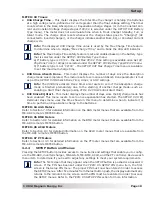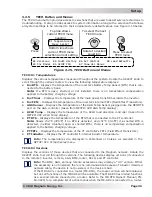
©
2014 Magnum Energy, Inc.
Page 23
Setup
Where should I set AC In - VDC?
Check with your battery manufacturer to determine the
correct settings for your batteries. Typically, manufacturers do not recommend discharging the
batteries below 50% (i.e., a voltage setting of approximately 12.0-12.2 VDC, 24.0-24.4 VDC and
48-48.8 VDC for 12, 24, and 48-volt batteries, respectively). To protect the batteries from over-
discharging, set to 12.2 VDC (12v), 24.4 VDC (24v), or 48.8 VDC (48v).
Set the disconnect voltage setting higher than the absorb voltage setting in order to reduce cy-
cling of the system. A setting higher than the absorb voltage requires the energy source (solar,
wind, etc.,) to raise the DC voltage above the charger settings. This ensures the battery gets at
least an 80-85% charge (preferably 100%) before the AC is disconnected and the inverter re-
sumes powering from the batteries.
• 02E AC In - SOC
– These settings determine when the inverter automatically connects/
disconnects the incoming utility power based on the State of Charge (SOC) of the inverter’s
battery bank.
◊
Connect SOC
– This setting determines at what battery SOC% the inverter/charger con-
nects to incoming utility power and transfers the loads from the inverter battery power to the
utility grid.
Default setting:
80% SOC
Range:
20-99%
◊
Disconnect SOC
– Once the inverter has connected to the incoming AC—based on the
SOC
Connect
setting—this setting determines at what battery SOC% the inverter/charger
disconnects from incoming utility power and resumes powering the loads from the inverter’s
battery power.
Default setting:
100% SOC
Range:
21-100%
Info:
If
Connect SOC
is selected and the incoming AC connects, the router issues
a one-time “Start Bulk” command to the inverter/charger. This ensures the charger
enters the Bulk/Absorb charge cycle regardless of battery voltage.
Info:
The transfer to/from incoming AC occurs immediately when the
Connect
SOC or
Disconnect
SOC setting is reached.
Info:
A ME-BMK is required in order to use the
02E AC In - SOC
setting. If this setting
is established and there is no ME-BMK installed in the system, or if a valid SOC number
is not displayed under the
METER: 05 BMK Meters/05B Battery SOC
menu (i.e.,
Think’n
,
No Comm
,
Power-up Fault
and
Factory Fault
are not valid SOC numbers), then the
inverter will not connect to the incoming AC power.
What is the AC In - SOC feature?
This feature allows the inverter/charger system to automati-
cally switch between utility connected and standalone battery operation based on the inverter’s
battery SOC (per the ME-BMK battery monitor). When using this feature, the inverter loads are
normally powered from the battery and a solar array (or wind, and/or hydro). In the event the
solar array cannot deliver enough power and the battery’s SOC drops to the
Connect
SOC setting,
the inverter connects to the utility to continue powering the loads connected to the inverter’s out-
put and to charge the battery. Once the solar array can again deliver enough power to charge the
battery to the
Disconnect
SOC setting, the inverter disconnects from the utility and again powers
the inverter loads from the battery.
Where should I set AC In - SOC?
Check with your battery manufacturer to determine the cor-
rect settings for your batteries. For the
Connect
SOC setting, most manufacturers do not recom-
mend discharging the batteries below 50% to maintain the life of the battery. Set the
Disconnect
SOC value to get at least an 80-85% charge (preferably 100%) before the AC is disconnected and
the inverter resumes powering from the batteries.
Info:
When using the
AC In - SOC
setting, ensure the
SETUP: 03D Absorb Done SOC
setting is higher than the
Disconnect
SOC setting or the inverter may not disconnect
from the incoming AC because the battery may not be charged to a high enough SOC
level to meet the
Disconnect
SOC setting.
















































